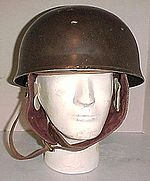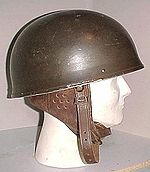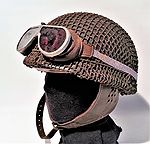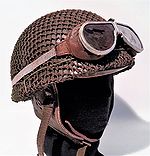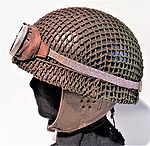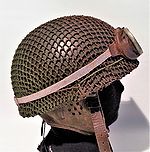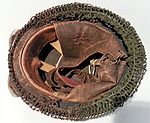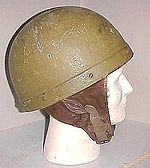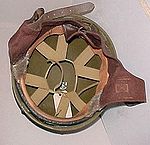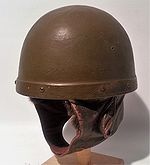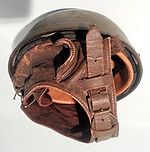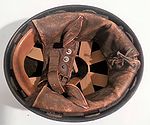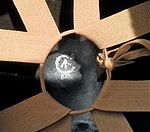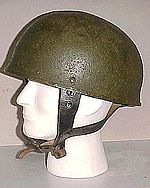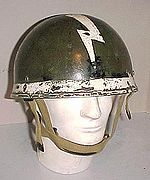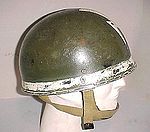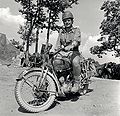Despatch Rider Helmets
The following is extracted from Tin Lids, written by Roger Lucy, which is a detailed history of the acquisition and use of steel helmets in the Canadian Army. The book is published by Service Publications, and a second edition copy can be ordered online. This section appears with the kind permission of Roger Lucy, the author, who maintains the copyright on all material.
Despatch Rider's Helmets
Prior to 1940, Canadian Dispatch Riders (DRs) wore no special protective head-gear, other than the standard steel helmet, when combat conditions so dictated. First Canadian Army soon noted that fibre crash helmets were being worn by British Army motorcyclists. On March 30, 1940 the Chief of Staff of First Canadian Army recommended that crash helmets be procured and that 700 would be required for the DRs and Military Police in each Canadian division. CMHQ accepted this recommendation. On April 17 it ordered 750 off-the-shelf helmets, "conforming largely to the British War Office pattern", from Charles Owen & Co. in London. Helmets were subsequently purchased from the firm Helmets Ltd. of Oxford.
British made "pulp" DR helmets, have a high egg-shaped crown, an external lace (sometimes covered by tape) passing through eyelets attaches the webbing liner to the shell. A cloth-lined basil-leather to protect neck and sides of the face is sewn between the shell and the liner and fastened with a strap and buckle and sometimes additional pop-studs. An improved model has a somewhat flatter profile while a raised rim with squared groove inside protects the connecting lace from damage. First Canadian Army Routine Order of 27 July 1941 ordered that all DR helmets be painted matt khaki green #3.
Efforts to procure DR helmets in Canada and the USA met limited success. An unknown number of an off-the-shelf low-crowned fibre crash helmet with a padded rim were procured from the Canadian branch of Spalding Sporting Goods Ltd. in late 1942. There is no indication that these were used overseas, but they were still in use by RCASC and the Provost Corps motorcycle demonstration teams in the late 1950s. In late 1942, the Army Technical Development Board began a more formal process of developing a Canadian-made DR helmet, Project 1001-2. Requests for prototypes were sent to Spalding, Backstay Standard, and Dunlop, on November 10, 1942. Spalding's helmet was rejected as the Diamond State fibre used in its helmet shell was too water absorbent. Backstay and Dunlop shells were more satisfactory, but preference was expressed for a shell made of phenol-formaldehyde impregnated sisal fibre submitted by the Sponge Rubber Co. in December. User trials of these helmets were very favourable.
Meanwhile the British had adopted a steel DR helmet. On September 30, 1942, CMHQ advised National Defence Headquarters that the War Office had adopted three new steel helmets using a common shell the Helmet DR, Steel Mk.I or Helmet, Steel No.3 for Dispatch riders, the Helmet, Steel No.4 for Armoured Fighting Vehicle crews and the Helmet, Steel No.5 for paratroopers. Production was to begin shortly, at which time samples would be available for Ottawa. On December 23, First Canadian Army advised CMHQ that the DR and AFV helmets would be adopted on the same scale as for the British Army.
At National Defence Headquarters' request CMHQ sent the specifications and samples of the steel DR helmets to Canada in April, 1943. Their arrival seems to have come as a surprise to Army Technical Development Board, but the design was enthusiastically received. The trials were very favourable, and in July, 1943 a Contract Demand for 14,000 DR Steel, Mk.I helmets was issued. On September 14, an OIC authorized the acquisition of the 10,000 steel shells from the Canadian Motorlamp Co. The shells were sole sourced on the grounds that as helmet makers the Canadian Motorlamp Co. had a substantially lower rejection rate than General Steelwares or Aluminum Goods Ltd. For some reason it was not until August, 1944 that the contract for the liners was authorized. The contract was awarded to Backstay Standard. Curiously sole-sourcing was justified on the seemingly incorrect grounds that Backstay Standard had the necessary experience in making helmet liners. At some point in 1943, the order was readjusted to 10,000 steel and 4,000 plastic helmets, and in late 1944, with the war in Europe ending, the order for liners to the steel version was cut back to 5,000 units.
Known in Canadian service as the Helmet, Crash, Motor Cyclists Steel or A15550, these helmets differ from British DR steel helmets in several minor ways: the base of the shell is a little larger and the rim is somewhat more flared. The shells have an inked C stamp, and the marking C.L./C. 1944 and an L or S for the size impressed in the rear shell. The liners are stamped are padded with sorbo rubber in lieu of felt, have a wider chin-strap than British made versions (18.5 compared to 12.5 mm), and are marked BS. The Helmet, Crash, Motor Cyclists Steel remained in Canadian Forces stocks until 1980.
The order of fibre helmets (apparently from Backstay Standard - as their BS logo is found in the liners) was placed some time in 1944. Termed Helmet, Crash, Motor Cyclists, Plastic or A15500, it is similar in general form to the British Helmet, Crash, Despatch Riders, but has grommeted vents set in the centre front and sides of the shell while the liner band is attached by 8 washered screw bolts set in the raised rim. The leather curtain, lined in cloth, has fixed ear guards and small gussets of rabbit fur at the temples, a concession, no doubt to Canada's climate.
Since W.W.II Canadian military motorcyclists (and those using snow-mobiles) have used a variety of non-ballistic civilian or police style crash helmets. An effort was made in the 1970s to standardize on the Crown 3000 Police Highway patrol type crash helmet, however the current policy is for off the shelf acquisition of commercial helmets at the unit level.
A special note on DR helmet conversions: In the late 1940s as Canada began to restore its airborne capability, the supplies of paratroop helmets were soon depleted, no new production was available from the UK or US, so a number of Canadian-made DR Steel Mk.I helmets were converted to airborne use and issued to the Van Doos and RCRs. The conversion consisted of inserting a top pad, cutting off the curtain and chin-strap and boring 4 holes in the rim to take the leather Airborne Mk.I harness. The helmets were worn reversed so the brow pad on the DR helmet becoming a neck support on the Airborne helmet. Reports from the units indicated that these conversions were considered very unsatisfactory. Nonetheless they were used until new supplies of Airborne Mk.II helmets became available in 1952. Thereafter some were further converted by boring yet more holes in the rim to accommodate the three-point web harness of the Mk.II Airborne helmet.
Canadian Steel DR Helmet
Plastic DR Crash Helmet
Canadian Steel DR Helmet Converted to Airborne Mk.I Configuration
Canadian Steel DR Helmet Converted to Airborne Mk.II Configuration
